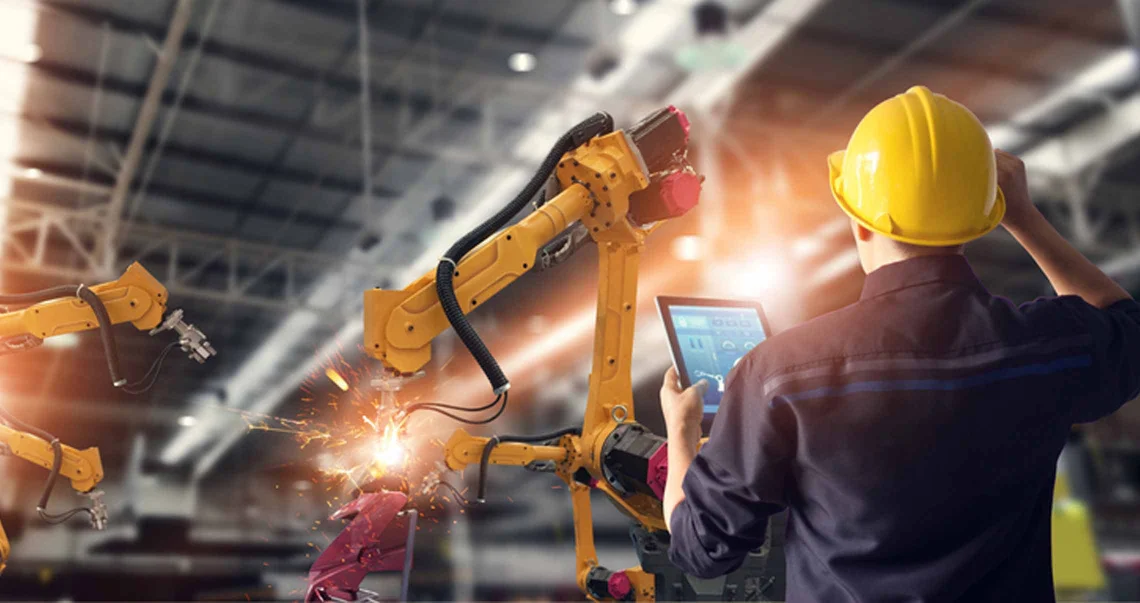Digital banking for business
Seamlessly access all of your accounts from one place with First Citizens Digital Banking for business.
Cutting-edge technology makes manufacturing operations more efficient. Even traditional manufacturers have begun to embrace the transformative power of automation and the Internet of Things, or IoT.

These companies aren't aiming to replace the human factor in their processes but rather to optimize a combination of core elements, including human power, machinery and robotics. Manufacturing companies that successfully integrate IoT elements can achieve greater efficiencies—transforming their businesses and bringing the customer experience to new heights.
There are billions of intelligent devices out there connectable to other devices and systems through closed and open networks. Cell phones, package scanners, vehicle trackers and equipment sensors are some common examples. Besides being on a network, these intelligent devices can perform tasks and share information with other devices and systems. This connectivity is what we refer to as IoT.
Using software and strategic process planning, manufacturing automation systems can take advantage of this connectivity to:
IoT in manufacturing can help improve a range of operational areas. With IoT, companies can remotely monitor equipment and production, collect data for autonomous manufacturing or engage in predictive analytics for better performance and asset management.
With cloud-based analytics, sensors inside robotics and other high-tech machinery can anticipate mechanical failures or alert workers of improper use. Companies can use automation to optimize plant functionality by creating separate profiles for each part of a plant. For example, environmental sensors and controls can help save energy costs and keep areas comfortable for workers while turning the HVAC off to avoid waste when the area is unoccupied. Connected technology can also control access to parts of a facility or even a specific piece of equipment based on which employees are authorized.
The benefits of IoT integration are numerous.
Supply chain management is known for its complexity and dependency on timely access to information. Using IoT, companies can keep track of raw materials, inventory and other assets in real time and with less human error. For example, GPS tags, sensors and scanners can make ongoing cycle counts as products leave the assembly floor. Temperature thresholds for perishable goods in inventory or within the supply chain can be monitored via devices that report power losses and refrigerated transport delays.
On the consumer side, automation and IoT can improve the customer experience and strengthen brand loyalty. Geofencing technology, for example, can offer personalized recommendations and incentives based on a customer's location or even their proximity to a competitor. Manufacturers can also include features that allow customers to control, track check or re-purchase products using smartphones.
IoT-enabled sensors can remotely monitor machines, scrutinize patterns, detect flaws and automate routine maintenance tasks to ensure seamless operation.
IoT devices can help to streamline inventory and supply chain management by augmenting shipping routes, shortening lead times and collating data related to theft and spoiled goods.
With multiple IoT sensors, data can be gathered on everything from speed and temperature to pressure, humidity, luminosity, movement and more. This is helpful for everything from transportation and shipping of goods to energy and resource monitoring.
IoT solutions embedded in clothing can do anything from monitoring heart rate and other vitals to detecting damage and environmental hazards.
According to Nexford University, IoT may help a variety of industries including transportation and logistics, banking and healthcare.
Many types of automation technology can improve efficiency in a variety of manufacturing use cases. Deciding where to start can be a challenge. Automation is typically an ongoing process, partly because incremental changes tailored toward specific operational areas are more manageable than wide-scale transformation. In addition, technology and business needs can change, requiring new approaches.
Consider targeting devices and systems with flexibility in design, movement, reusability and interconnectivity. As your manufacturing business relies more on the integration of subsystems and modular components, those device features will continue to help improve overall efficiency and reduce costs down the road.
Most importantly, the way your business uses these technologies should match its needs and strategy. A sound financial strategy is a key component for making manufacturing automation systems work best, especially if robotics and other high-priced technologies are needed. Reach out to your banking partner for guidance.
Email Us
Please select the option that best matches your needs.
Customers with account-related questions who aren't enrolled in Digital Banking or who would prefer to talk with someone can call us directly.